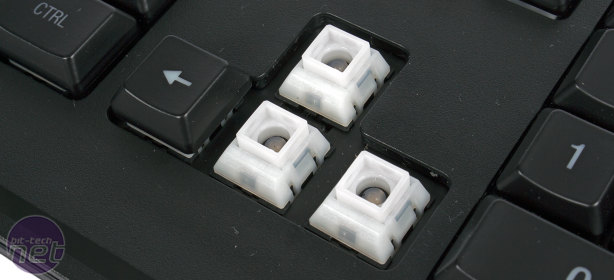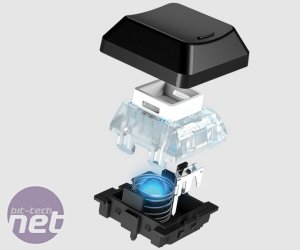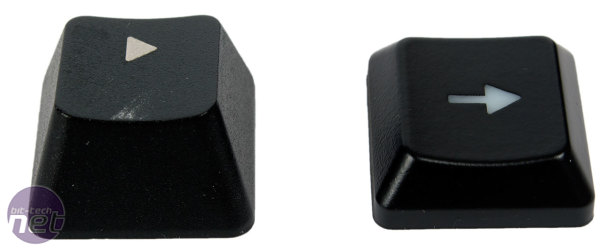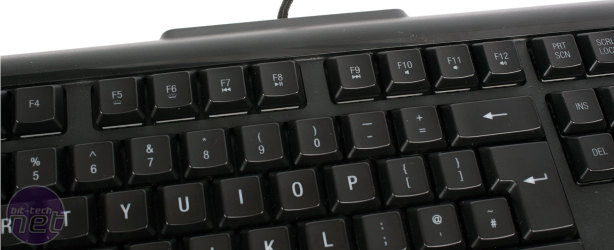
Performance
The QS1 switch used in every key of the Apex M800 is a joint effort from SteelSeries and Chinese manufacturer Kailh, which is known for imitating Cherry MX switches as it has done on the latest generation of Razer mechanical keyboards. However, the QS1 is not like this – it is an entirely new and exclusive design. While we always appreciate a company doing something new like this, the downside is that the QS1 switches have no keycap compatibility beyond those with which the Apex M800 ships with, so customisation is, for now, off the cards.It's fair to say that Kailh does not enjoy the same sterling reputation with regards to engineering quality as other manufacturers like Cherry or Topre, and SteelSeries does not appear to be giving the relationship too much publicity. Nonetheless, the switches, like those that Razer uses, are rated for a lifetime of 60 million clicks (Cherry MX switches are 50 million), though we do not have the facilities to test this claim. SteelSeries says that it does heavy sorting for its switches, and is actually pushing the boundaries of any sorting Kailh has previously done. The company also has its own secondary test set up at its assembly plant that is currently used to test 100 percent of all QS1 switches produced. With that said, let's take a closer look at the QS1 switch.
The QS1 switch has a square-shaped plunger onto which the keycaps are fitted. The plunger and the spring it sits on top of leave space in the middle large enough to house a surface-mounted RGB LED. This stands in contrast to Cherry MX and Cherry MX RGB switches, whereby any LEDs are fitted to the top. Coupled with the QS1's translucent housing, the result is a very even backlighting on all keys, and this is especially noticeable on dual symbol keys.
In terms of key action, the closest comparable switch is the Cherry MX Red, as the QS1 is fully linear with no tactile bump or audible click in the design, and the actuation force is also the same; 45cN. However, it is a shorter switch, with a total travel of only 3mm (compared to 4mm on the Reds) and a closer actuation/reset point of 1.5mm compared to 2mm on the Cherry MX design. It is this latter point which leads SteelSeries to claim the QS1 is 25 percent faster to actuate than a traditional mechanical switch. As well as the shorter stem, SteelSeries also uses very low profile keycaps – in fact, as you can see in the side by side shot next to one from a Corsair Vengeance K60, they are about half the height of ones you would find on a Cherry MX-based keyboard. The result is a mechanical keyboard that is surprisingly low profile.
So, how do the QS1 switches and the Apex M800 actually perform? The answer, generally, is really well. The action is indeed very smooth and linear, and the keyboard does feel extremely fast and responsive. Game-changingly so? Perhaps not, but it's nonetheless a very enjoyable experience both when typing and gaming, and the shorter actuation point and travel is certainly noticeable as well.
As mentioned, we didn't have any trouble getting accustomed to the layout and the unusual space bar design. The whole keyboard has a low-profile layout and a low angle, which is said to cut down on finger travel distance. Meanwhile, the keycap shape is said to be 'optimised for speed', and unlike most mechanical keyboards the keycaps surfaces are all aligned on a single plane, so you don't have to lift your finger slightly when moving to a key in the row above, for example. Instead, you're able to glide across the keys rather effortlessly. Honestly, we're really impressed by what SteelSeries has managed with the Apex M800. Going back to a Cherry MX-based keyboard, the keycaps felt a little oversized and the extra distance was noticeable as well. The low-profile keycaps here also mean it's easier to clean between the keys, although for a proper debris clear out you'll still want to pull off the keycaps.
Upon closer investigation, we found that the QS1s are not entirely linear, strictly speaking – there is a very slight notch at the actuation/reset point. In fact, it would be more accurate to say extremely slight, as in regular use you don't notice it, and we were only able to detect it through multiple, deliberately slow presses through the entire action, and it was a tad more noticeable on the way up. What this leads to is the keys feeling stickier than Cherry MX Reds when bottoming out, albeit ever so slightly. However, the keys never actually get stuck and there's none of the mushiness or delayed rebound that you'd associate with membrane keyboards – as we said the Apex M800 is still rapid and responsive to use. In fact, the slight (again, very slight) change in pressure when the key actuates actually allowed us to find and ride the actuation point easier than with Cherry MX Reds, where it is entirely undetectable – some may find this beneficial in games that require multiple rapid key presses.
One final thing to note about the Apex M800 is that it is easily the quietest mechanical keyboard we've used, including Topre-based ones. Even non-tactile, non-clicky Cherry MX Reds can be relatively loud to use, especially compared to membrane keyboards. It is possible to purchase o-ring dampeners to minimise this effect, but this only really helps when bottoming out – the keys can make quite a racket on the return journey too. However, with the QS1 switches and low-profile keycaps here, it's almost as quiet as typing on a traditional membrane keyboard, with the traditional clicky sounds being very much dampened. Of course, many enthusiasts relish the clicky sound, but others (like Antony, for example) can't bear it. Oddly, SteelSeries hardly advertises the low noise of the Apex M800 at all, but we can see it being picked up upon and becoming a significant selling point for the keyboard.

MSI MPG Velox 100R Chassis Review
October 14 2021 | 15:04













Want to comment? Please log in.